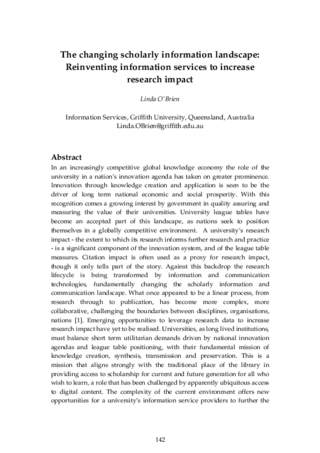In an increasingly competitive global knowledge economy the role of the university in a nation’s innovation agenda has taken on greater prominence. Innovation through knowledge creation and application is seen to be the driver of long term national economic and social prosperity. With this recognition comes a growing interest by government in quality assuring and measuring the value of their universities. University league tables have become an accepted part of this landscape, as nations seek to position themselves in a globally competitive environment. A university’s research impact - the extent to which its research informs further research and practise - is a significant component of the innovation system, and of the league table measures. Citation impact is often used as a proxy for research impact, though it only tells part of the story. Against this backdrop the research lifecycle is being transformed by information and communication technologies, fundamentally changing the scholarly information and communication landscape. What once appeared to be a linear process, from research through to publication, has become more complex, more collaborative, challenging the boundaries between disciplines, organisations, nations [1]. Emerging opportunities to leverage research data to increase research impact have yet to be realised. Universities, as long lived institutions, must balance short term utilitarian demands driven by national innovation agendas and league table positioning, with their fundamental mission of knowledge creation, synthesis, transmission and preservation. This is a mission that aligns strongly with the traditional place of the library in providing access to scholarship for current and future generation for all who wish to learn, a role that has been challenged by apparently ubiquitous access to digital content. The complexity of the current environment offers new opportunities for a university’s information service providers to further the university, and the nation’s aspirations – both short and long term. Information service providers are ideally positioned to navigate the complexity of the scholarly information landscape to achieve university imperatives within a national context, through collaboration within and across organisational boundaries; to achieve short term imperatives whilst staying true to the long term mission of universities in knowledge creation, dissemination and preservation for future generations of scholars and practitioners. Griffith University, a research intensive, innovative university situated within the south east corner of Queensland, Australia enjoys the benefit of an integrated information services division. Information Services brings together library, information and IT professionals to provide the information leadership, services, systems and infrastructure which underpin the University’s research, learning, teaching and administrative activity. Over the last twelve months the division has built on its strengths to re-shape its services to tightly align them with University’s aspirations. A significant part of this re-shaping has been the implementation of new service models, new services and systems, and strengthened partnerships, to increase the University’s research impact. This initiative has been welcomed by the academy. More complex measures will be required to indicate the success of this initiative over time.
O'Brien, Linda. "The changing scholarly information landscape: Reinventing information services to increase research impact." In Publishing in the networked world: Transforming the Nature of Communication, 14th International Conference on Electronic Publishing, 142-166. ELPUB. Helsinki, Finland, 2010.
